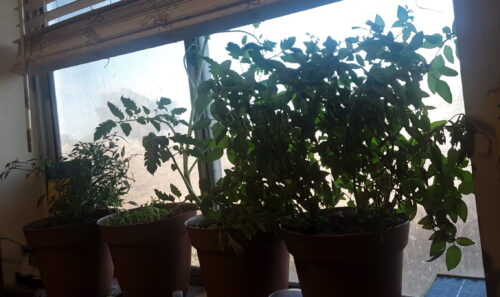
Hi there, K again. In this post, I continue the theme of beginning the process of sustainable living even when on the grid. Here I focus on reducing food costs through small-scale/container gardening. Why start small? There’s nothing worse than setting up a thousand square foot garden, planting it, and having almost nothing sprout because you didn’t know what you were doing. With this type of experience, you may get discouraged from trying again. Take heart. You don’t have to do it the same way twice.
As you consider creating a small garden, you will need to keep in mind your living situation. Maybe you have an apartment with a patio where you can do some container gardening. Maybe you have access to a rooftop. Perhaps you live in a garden apartment with a small plot of land either in front or back of your living space. You may only have window boxes, but you can still supplement your food with herbs and peppers. All you need is a little sunshine (or grow lights), a little dirt, and a little water and you can have a garden anywhere you live.
When I started, I used a spare bedroom with south-facing windows to grow peppers, tomatoes, and some lettuce greens. As long as the peppers and tomatoes don’t get too cold, they’ll continue to grow. If you fertilize them properly, they’ll even continue to produce all year long. I just set up self-watering planters on the floor near the windows so sunlight could reach them. I also set up CFLs (compact fluorescent lights) to supplement the sunlight. I was able to harvest tomatoes and peppers within 3 months of planting.
Here in the high desert, since I was on a tight budget, I decided to grow things from seed. I started out by getting some self-watering planters, filled them with soil, put in the seed, and then covered them again with a thin layer of soil. I then put them on a propagation mat (easily obtainable at gardening stores or big department stores with a gardening section) and set it for the optimal temperature for germination, between 75 and 80 ᐤF for peppers and tomatoes. Since tomato, pepper, and lettuce seeds are so small, I used a bottle sprayer to water them so I wouldn’t dislodge the seeds and break the roots. (Phoenix did not know to do this when she first started germinating lettuce seeds and experienced multiple epic failures that she could not explain; she only later understood that a hose would destroy the root systems.) You only need to use spray bottles with small seeds. With bigger seeds such as corn, beans, and peas, it is best to soak them for twenty-four hours before planting them.
As the plants grow, give them doses of all-purpose fertilizer appropriate to the types of plants you’re growing. Remember, before you can get tomatoes or peppers, the plants need to produce flowers and the flowers need to be fertilized. Once the blossoms open, spray them with tomato blossom set spray, which works for several different types of vegetables including tomatoes, cucumbers, eggplants, peppers, okra, beans, and strawberries. The spray contains the plant hormone kinetin promoting blossom production and fooling the plant into fruit development even without pollination. The seeds won’t be viable (that is, able to germinate into plants), but the fruit will be just as tasty as one from a fertilized blossom. If you don’t want to go through the trouble of germinating seeds, which can be challenging, just get some seedlings. Focus just on those you love to eat and you won’t break the bank.
As you practice with small-scale/container gardening you’ll figure out what you like and what needs to be done to be successful in gardening at a larger scale. You are one step closer to sustainable living.
Next blog post: Part 5: Possible solutions for your sustainable living–avoiding gardening pitfalls (By K)
